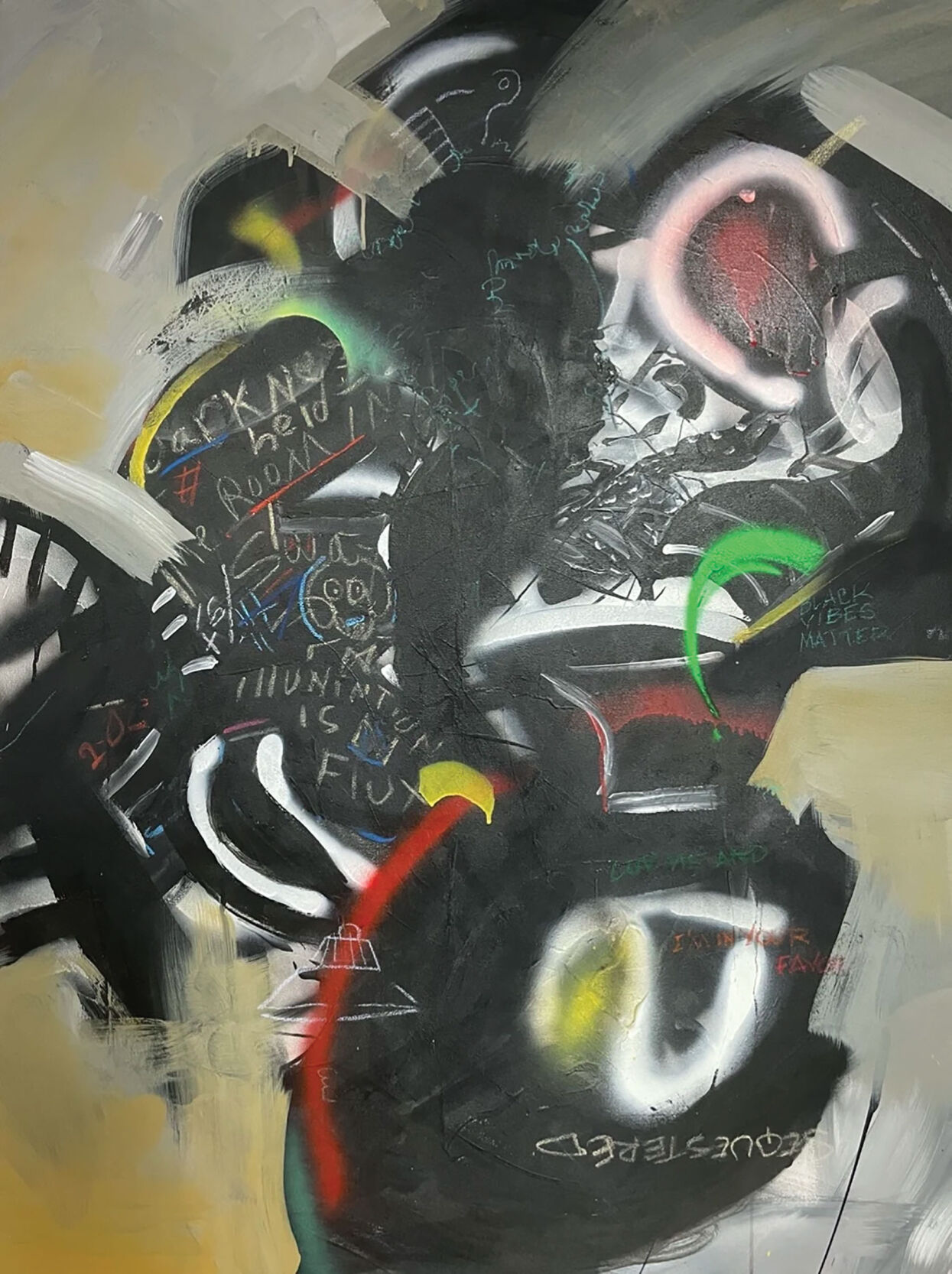Funkadelic planted its freak flag in the American music landscape with its eponymous debut album, which touched down on the dividing line between 1960s soul and 1970s funk. Funkadelic, released in 1970, married soul music arrangements with fuzzed-out electric guitars, nodding to Jimi Hendrix and Vanilla Fudge as well as the Motown Sound. Funkadelic founder George Clinton cut his teeth as a staff songwriter at the Detroit label in the 1960s, but his musical destiny drew him away from the Motor City — ultimately, very, very far out. Clinton’s music evolved into the Parliament-Funkadelic collective: a band of rotating musicians playing in two distinct styles and enmeshed in the cosmic mythology that’s folded into the band’s liner notes, album art, insider lingo, lyrical content, and fried-kaleidoscope costume and stage designs.
Clinton’s latest proclamations of funkology take the form of the painted canvases he’s been exhibiting since the late 1990s. Lots of Clinton’s boomer musical peers also make paintings, but where Paul McCartney and Ron Wood’s visual art habits feel ancillary to their musical artistry, Clinton’s gallery displays are anchored in a larger multimedia universe that he’s been expanding for six decades. The artist’s exhibition at Cëcret by Cë Gallery in Wedgewood-Houston is by turns familiar, fresh and very funky.

“Easy Rider,” George Clinton
Cë Gallery’s Wedgewood-Houston outpost Cëcret has taken over one of the May Hosiery Mill building’s event spaces to accommodate the expansive Grooves From the Deep and the Space Math of George Clinton. The work in Grooves From the Deep was made during the worst of the pandemic, and a smaller version of the exhibition was displayed at the George Washington Carver Museum in Miami in March. This version of Grooves From the Deep includes 31 stretched canvases that vary in size and mix figurative, representational and abstract elements with the same kind of stank and sexy gumbo recipe that informs P-Funk’s best arrangements and studio productions.
Clinton uses acrylic, marker and spray paint, and his art — like his music — can be thoughtful and detailed as well as chaotic and improvisational. “Easy Rider” is one of the strongest pieces in the show. It appears totally abstract from a distance, but upon closer examination, a central figure emerges along with messages written in text: “sequestered” and “black vibes matter.” The figure resembles a Kara Walker-style silhouette, but its face is outlined in delicate lyrical squiggles of sky blue. It’s one of my favorite discoveries in this show.
“Easy Rider” has a black, red and green palette that echoes the Pan-African flag, which symbolizes solidarity among the people of the African diaspora. Parliament-Funkadelic’s funkology is one of the cornerstones of Afrofuturism, alongside the science-fiction of Samuel R. Delany and Octavia Butler, and comic book heroes like Marvel’s Black Panther. Parliament-Funkadelic’s myth-making echoes the cosmology of Sun Ra’s Arkestra, but warp-drives the interplanetary vibes with heroic doses of LSD. Grooves From the Deep features lots of UFO imagery and titles like “Watching Us.” “Straight Outta Dogon” connects the astrology of the indigenous Dogon people of Mali, West Africa, to 1980s gangsta rap. The painting features a drawing of a long-eared dog in a tuxedo and a bowtie that’s superimposed over a yellow UFO.
The Dogon cosmology is focused on Sirius — it’s known as the “Dog Star” for its prominent place in the constellation Canis Major. “Straight Outta Dogon” finds Clinton introducing his Atomic Dog character, which appears on canvases throughout the show. “Atomic Dog” is a hit from George Clinton’s 1982 solo album Computer Games, and sampled riffs, beats and vocals from the song can be heard in tracks from Snoop and Dre to Herbie Hancock and Prince. The painterly pooch is Clinton’s visual art signature — like Keith Haring’s dancing man, Jean-Michel Basquiat’s crowns, and even Degas’ ballerinas. The Atomic Dog reads like a logo, contextualizing Clinton’s exhibitions within the greater funkology, and translating that universe from black vinyl to white walls.
Before I realized its talismanic power, Clinton’s canine character struck me as a minor player in Grooves From the Deep, which includes much more formally sophisticated paintings. “Observed Expansion” is a Rorschach blob of black paint floating in a desert of dappled rose and clay — the composition reads like a Clyfford Still painting. “Hatshepsut” is a gorgeous arrangement of yellow, red and black forms all lashed together in looping gestures of ghostly white spray paint on a gray background. The canvas is named for a female Egyptian pharaoh, and Clinton counts the art of ancient Egypt among his influences. To quote Osiris from the Egyptian Book of the Dead, “If you ain’t gonna get it on, take your dead ass home.”



